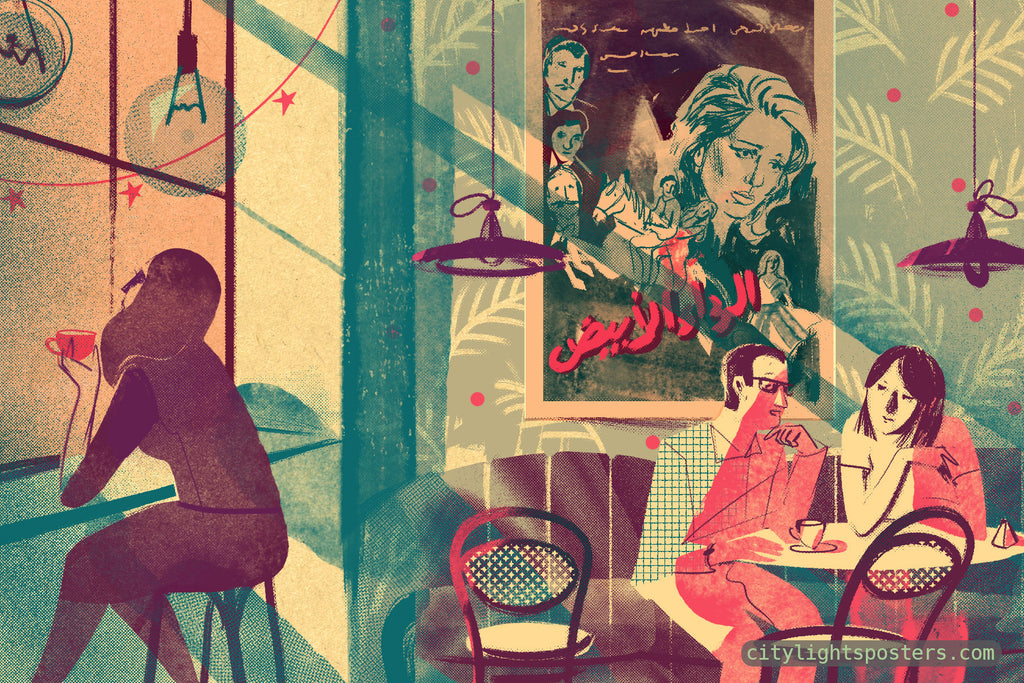Graphic Nostalgia in Egyptian Cinema Posters

When I stood in front of the wonderful collection of City Lights Posters, trying to decide which poster I want to pick and add to my own collection, I knew this was going to be a very tough choice to make. Each of these old Egyptian movie posters was a piece of art on its own. Each of them reflected in a unique way the “golden age” of Egyptian cinema, expressing it in a graphic language that some rightfully argue is one of strongest visual styles in the history of Arabic graphic design. Posters from the 50s had a rare value that made them so treasured, while those from the 60s had an indescribable charm in the way they combined chaos and order in rich compositions of typography and illustrations. Posters form the 70s were characterized by attractive color combinations and unconventional Arabic lettering for the movie titles. Posters from the 80s stood out as a typical reflection of the decade’s graphic design style that was very familiar to me from my childhood.
 |
My choice finally settled on the poster of the movie The Madness of Love (Jonoon El-Hobb / La Folie de L’Amour). There was something about the composition and design of this poster that made me simply fall in love with it. Maybe it was the beautiful depth in the illustration of Naglaa Fathi, depicting with fascinating brushstrokes her fabulous hair styling, or maybe it was the brilliantly-matching color palette that surrounded the orange focal point of the poster, or maybe it was simply the beautiful and inspiring Arabic hand-lettering of the movie title. But that is the beauty of these posters: you love them and with time you keep discovering why you connect so much with them. This is exactly why I find them a great choice as artwork framed and displayed within interior spaces. The office of my design studio, Tarek Atrissi Design, has more than 10 of these original vintage Egyptian movie posters hanging in their typical large formats of 70 x 100 cm. A couple of others are hanging in my home as well. Beyond adding a very special character to the space where they are displayed, my relationship with these posters develops with time, as I keep seeing each of them in new ways, and keep getting inspired by their design in surprising ways, not to mention constantly noticing new details in each of them.
 |


The Madness of Love poster I have picked brought me a nice surprise after a couple of months of hanging right in front my working desk. As I started looking to know more about the work of the artist behind it, Gassour, my mother pointed out that this artist is the one who had painted another piece that was very familiar to me: a portrait of my late grandfather that has always been hanging in my grandparents’ house. That portrait is a strong part of my childhood’s visual memory. This opened the door for much comparison between the artist’s artworks, and a closer critical look at my grandfather’s portrait made me value it even more than my initial personal attachment to it. A great artist was behind this painting, the same one who designed many of these posters that are widely known and loved by many of the fans of Egyptian cinema all over the Arab world. Suddenly, a lot made sense in my grandfather’s painting, the most present image of him in my mind: the harmony and technique of colors, the depth of the illustration and the delicate balance between the realistic depiction and the extraordinary feeling of the illustration style were all the same traits found in pieces by Gassour. While one was a design commission for the promotion of a commercial movie and the other a personal commission for an artistic portrait painting, both pieces were finally valued pieces of art that were worthy of being displayed and cherished for long periods.
 |
Egyptian posters have always been part of my childhood, as part of the common visual language that I frequently saw around me: on television, on VCR packaging, in the streets, and on various cinema marketing materials. The first time I saw these posters outside their usual context was at the Beiteddine Festivals in Lebanon at the beginning of the new millennium. An exhibition celebrating the rich history of these posters displayed an amazing selection of real size originals at the festival. The exhibition, entitled “Love Story”, opened my eyes for the first time to the artistic value of these posters, and reached the wider public attending the festival by highlighting the unknown love story each of them had with these posters. The article of the late journalist Samir Kassir, covering the exhibition, was probably the most articulate analysis of the history of these posters and their graphic and artistic importance. Kassir looked beyond the glamour of these posters to note the social impact they had: liberating women from their stereotypical image within the conservative Arab world, and regaining them their body freedom, making the female stars sometimes stand as tall as buildings in large-format posters.
Kassir noted as well the importance of these posters on the overall development of the graphic design scene in the region, as their peculiar style developed to be seen in various printed layouts as well as book and magazine covers. Retrospectively looking as a triumph of “kitsch”, the design of these Egyptian posters had so much richness in its visual vocabulary, positioning them as a strong mode of expression that became the most popular style in the region, acting as a “seal of quality” to any graphic piece produced then and after. The designers behind these posters were the real uncelebrated guest stars of these movies, visually producing one of the most thrilling stories of Arab modernity, yet one of the most neglected stories in the history of world art in the 20th century.
 |
To me personally, as a graphic and typographic designer, each of these posters remains a source of inspiration in my day-to-day work. The fantastic Arabic lettering design that can be found in these pieces is a particular area of interest, and has inspired us often in developing new concepts for some of the new Arabic typefaces we have developed through our type foundry, Arabic Typography. Every graphic designer looks at these posters and wishes his own design work will be regarded in the future with the same appreciation these posters are looked at, many decades after their initial creation.
Tarek Atrissi is an award winning graphic and typographic designer, running his Barcelona-based graphic design studio, Tarek Atrissi Design (www.atrissi.com), and specializing in branding, Arabic typography, and exhibition design. Atrissi received the distinguished alumni awards from both the American University of Beirut in Lebanon and the School of Visual Arts in New York, as an acknowledgement for his contribution to the design field within the Arab world as well as internationally.
Subscribe to our newsletter to receive the latest latest blog updates, poster releases, and special offers.
